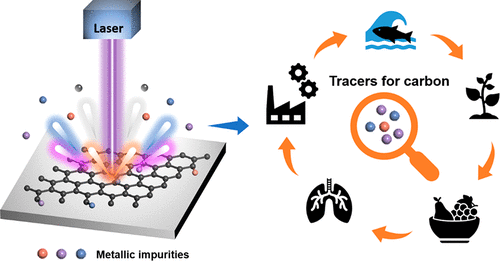当前位置:
X-MOL 学术
›
Anal. Chem.
›
论文详情
Our official English website, www.x-mol.net, welcomes your feedback! (Note: you will need to create a separate account there.)
Metallic Fingerprints of Carbon: Label-Free Tracking and Imaging of Graphene in Plants.
Analytical Chemistry ( IF 7.4 ) Pub Date : 2020-01-08 , DOI: 10.1021/acs.analchem.9b04262 Tuoya Zhang 1, 2 , Qian Liu 1, 2, 3 , Weichao Wang 1, 2 , Xiu Huang 1, 2 , Dingyi Wang 1, 2 , Yujian He 2 , Jiyan Liu 1, 2 , Guibin Jiang 1, 2
Analytical Chemistry ( IF 7.4 ) Pub Date : 2020-01-08 , DOI: 10.1021/acs.analchem.9b04262 Tuoya Zhang 1, 2 , Qian Liu 1, 2, 3 , Weichao Wang 1, 2 , Xiu Huang 1, 2 , Dingyi Wang 1, 2 , Yujian He 2 , Jiyan Liu 1, 2 , Guibin Jiang 1, 2
Affiliation

|
Detection and quantification of carbon nanomaterials are extremely challenging, especially under the background interference of carbon. Here, we propose a new label-free method to quantify, track, and in situ image graphene and graphene oxide (GO) in plants based on their inherent metallic impurities as fingerprints. We show the ubiquity and high stability of inherent metallic fingerprints of graphene and GO obtained from different exposure routes under the natural environments, which enables the materials to be easily quantified and in situ imaged by high-sensitivity (laser ablation) inductively coupled plasma mass spectrometry. The method was applied to investigate the uptake and spatial distribution of graphene and GO in soybean plants. The plants were cultivated in graphene or GO solutions for 7 days, and the indicative elements (Ni or Mn) in different parts of plants were monitored and imaged. We found that graphene and GO showed different distribution patterns in plants (the highest uptake percentages in root up to 14.4% for graphene and 47.8% for GO), and high concentration of material exposure might cause excessive accumulation of materials in roots which blocked their further transport to the other parts of plants. The present method is more straightforward, accessible, and economical than normally used isotopic or metal-labeling methods. It also avoids the uncertainties or alterations of properties caused by the labeling process and thus has great promise in analysis and risk assessment of carbon nanomaterials.
中文翻译:

碳的金属指纹:植物中石墨烯的无标记跟踪和成像。
碳纳米材料的检测和定量分析极具挑战性,尤其是在碳的背景干扰下。在这里,我们提出了一种新的无标记方法,基于植物中固有的金属杂质作为指纹,可以量化,跟踪和原位图像化植物中的石墨烯和氧化石墨烯(GO)。我们展示了在自然环境下,通过不同的暴露途径获得的石墨烯和GO固有金属指纹的普遍性和高度稳定性,这使得该材料可以通过高灵敏度(激光烧蚀)电感耦合等离子体质谱法轻松地进行定量和原位成像。 。该方法用于研究大豆中石墨烯和GO的吸收和空间分布。将植物在石墨烯或GO溶液中培养7天,对植物不同部位的指示元素(镍或锰)进行监测和成像。我们发现,石墨烯和GO在植物中表现出不同的分布模式(根部的最高吸收百分比,石墨烯高达14.4%,GO达到47.8%),并且高浓度的物质暴露可能会导致根部物质的过度积累,从而阻碍了它们的进一步生长运输到植物的其他部分。与通常使用的同位素或金属标记方法相比,本方法更直接,更容易获得和更经济。它也避免了由标记过程引起的不确定性或性能变化,因此在碳纳米材料的分析和风险评估中具有广阔的前景。我们发现,石墨烯和GO在植物中表现出不同的分布模式(根部的最高吸收百分比最高,石墨烯高达14.4%,GO达到47.8%),而高浓度的物质暴露可能会导致根部物质过多积聚,从而阻碍了它们的进一步生长。运输到植物的其他部分。与通常使用的同位素或金属标记方法相比,本方法更直接,更容易获得和更经济。它也避免了由标记过程引起的不确定性或性能变化,因此在碳纳米材料的分析和风险评估中具有广阔的前景。我们发现,石墨烯和GO在植物中表现出不同的分布模式(根部的最高吸收百分比,石墨烯高达14.4%,GO达到47.8%),并且高浓度的物质暴露可能会导致根部物质的过度积累,从而阻碍了它们的进一步生长运输到植物的其他部分。与通常使用的同位素或金属标记方法相比,本方法更直接,更容易获得和更经济。它也避免了由标记过程引起的不确定性或性能变化,因此在碳纳米材料的分析和风险评估中具有广阔的前景。高浓度的物质暴露可能会导致根部物质过多积聚,从而阻止其进一步运输到植物的其他部位。与通常使用的同位素或金属标记方法相比,本方法更直接,更容易获得和更经济。它也避免了由标记过程引起的不确定性或性能变化,因此在碳纳米材料的分析和风险评估中具有广阔的前景。高浓度的物质暴露可能会导致根部物质过多积聚,从而阻止其进一步运输到植物的其他部位。与通常使用的同位素或金属标记方法相比,本方法更直接,更容易获得并且更经济。它也避免了由标记过程引起的不确定性或性能变化,因此在碳纳米材料的分析和风险评估中具有广阔的前景。
更新日期:2020-01-08
中文翻译:

碳的金属指纹:植物中石墨烯的无标记跟踪和成像。
碳纳米材料的检测和定量分析极具挑战性,尤其是在碳的背景干扰下。在这里,我们提出了一种新的无标记方法,基于植物中固有的金属杂质作为指纹,可以量化,跟踪和原位图像化植物中的石墨烯和氧化石墨烯(GO)。我们展示了在自然环境下,通过不同的暴露途径获得的石墨烯和GO固有金属指纹的普遍性和高度稳定性,这使得该材料可以通过高灵敏度(激光烧蚀)电感耦合等离子体质谱法轻松地进行定量和原位成像。 。该方法用于研究大豆中石墨烯和GO的吸收和空间分布。将植物在石墨烯或GO溶液中培养7天,对植物不同部位的指示元素(镍或锰)进行监测和成像。我们发现,石墨烯和GO在植物中表现出不同的分布模式(根部的最高吸收百分比,石墨烯高达14.4%,GO达到47.8%),并且高浓度的物质暴露可能会导致根部物质的过度积累,从而阻碍了它们的进一步生长运输到植物的其他部分。与通常使用的同位素或金属标记方法相比,本方法更直接,更容易获得和更经济。它也避免了由标记过程引起的不确定性或性能变化,因此在碳纳米材料的分析和风险评估中具有广阔的前景。我们发现,石墨烯和GO在植物中表现出不同的分布模式(根部的最高吸收百分比最高,石墨烯高达14.4%,GO达到47.8%),而高浓度的物质暴露可能会导致根部物质过多积聚,从而阻碍了它们的进一步生长。运输到植物的其他部分。与通常使用的同位素或金属标记方法相比,本方法更直接,更容易获得和更经济。它也避免了由标记过程引起的不确定性或性能变化,因此在碳纳米材料的分析和风险评估中具有广阔的前景。我们发现,石墨烯和GO在植物中表现出不同的分布模式(根部的最高吸收百分比,石墨烯高达14.4%,GO达到47.8%),并且高浓度的物质暴露可能会导致根部物质的过度积累,从而阻碍了它们的进一步生长运输到植物的其他部分。与通常使用的同位素或金属标记方法相比,本方法更直接,更容易获得和更经济。它也避免了由标记过程引起的不确定性或性能变化,因此在碳纳米材料的分析和风险评估中具有广阔的前景。高浓度的物质暴露可能会导致根部物质过多积聚,从而阻止其进一步运输到植物的其他部位。与通常使用的同位素或金属标记方法相比,本方法更直接,更容易获得和更经济。它也避免了由标记过程引起的不确定性或性能变化,因此在碳纳米材料的分析和风险评估中具有广阔的前景。高浓度的物质暴露可能会导致根部物质过多积聚,从而阻止其进一步运输到植物的其他部位。与通常使用的同位素或金属标记方法相比,本方法更直接,更容易获得并且更经济。它也避免了由标记过程引起的不确定性或性能变化,因此在碳纳米材料的分析和风险评估中具有广阔的前景。



























 京公网安备 11010802027423号
京公网安备 11010802027423号